In a world moving increasingly to gigabit Internet there is no doubt that, everything else being equal, faster speeds are better, but at what point does speed make a difference? How much of a measurable economic development difference does faster deliver? For communities and regions looking to make their own business case, this detail is critical.
SNG’s research reveals that speed is indeed important, but that upload speeds (more so than download) have a greater impact on actual meaningful use and utilization amongst small and medium enterprises (SMEs). These businesses that make up 90% of all businesses have the most to gain from broadband utilization. With that, it is alarming that SNG research reveals:
- The economic benefits from broadband are severely limited unless you have at least 4 Mbps upload speeds.
- Over 70% of small businesses (fewer than 50 employees) have less than 4 Mbps upload speed [1], creating a barrier for these organizations.
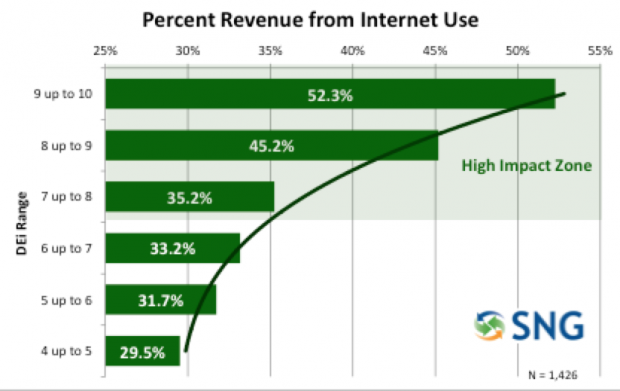 This is a major inhibitor to economic growth through broadband as SNG’s research shows that higher utilization of the Internet for online business activities brings higher revenues. SNG measures utilization using our own Digital Economy index (DEi), a normalized, weighted index of 17 potential online activities (eSolutions) covering a wide range of typical business functions. A DEi score of 10 means that all eSolutions are used, with a score of zero meaning that none are used. The average DEi score for SMEs is 6.6 (out of 10).
This is a major inhibitor to economic growth through broadband as SNG’s research shows that higher utilization of the Internet for online business activities brings higher revenues. SNG measures utilization using our own Digital Economy index (DEi), a normalized, weighted index of 17 potential online activities (eSolutions) covering a wide range of typical business functions. A DEi score of 10 means that all eSolutions are used, with a score of zero meaning that none are used. The average DEi score for SMEs is 6.6 (out of 10).
SMEs fully utilizing the Internet – a DEi score in the top range – generate 20% more of their total revenues from their online activities compared SMEs with an average DEi score. In a nutshell, the more – and more effectively – you use broadband, the more financial benefits there are to be realized by businesses. Higher utilization by SMEs increases direct revenues (and cost savings), which means greater and faster business growth, more jobs, and flow through impacts to the local economy.
Why is 4 Mbps upload speed a critical point?
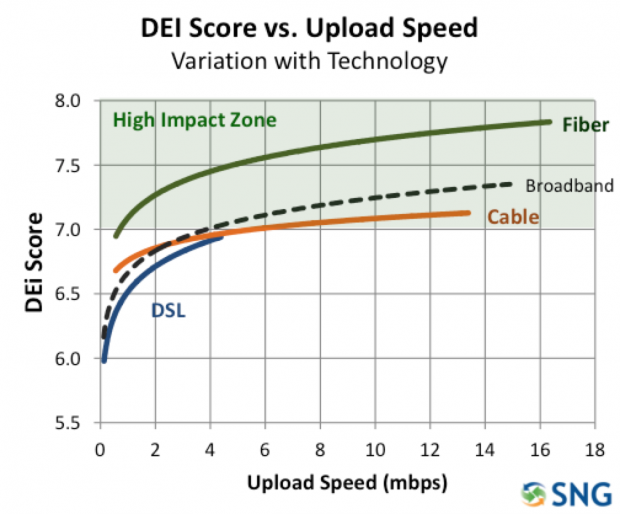 Comparing DEi scores (utilization) with upload speeds we see a high correlation with high utilization when upload speeds are above 4 Mbps. Below 4 Mpbs the utilization drops off significantly.
Comparing DEi scores (utilization) with upload speeds we see a high correlation with high utilization when upload speeds are above 4 Mbps. Below 4 Mpbs the utilization drops off significantly.
This effect is even more pronounced when broken down by the major broadband technologies in use today:
- The vast majority (71%) of fiber users have 4 Mbps of higher upload speed.
- Cable users experience a broad range of upload speeds, with only 42% above 4 Mbps.
- Over 92% of DSL SME users have less than 4 Mbps upload speed putting most DSL SMEs below the high impact zone.
Considering that about one-third of SMEs use DSL, one-third use cable, and only 8% use fiber [2], a significant portion of SMEs are constrained by lower DSL or cable speeds.
What does this mean for communities?
Speed alone will not drive utilization and impacts, but minimum upload speeds are a key enabler, empowering SMEs to take full advantage of broadband. Obviously the trend towards more fiber will help address this speed requirement. It is also important that when offering higher speeds with any technology that the service pricing is affordable compared to the lower speed alternatives.
A lot of resources have gone into broadband mapping, but to get a true read you need to do your own market research into which businesses in your area have access to 4 Mbps upload speeds and their Internet use – this may involve asking them to actually run the sped test in a survey. Identify the gaps in sufficient upload speed and make these a priority for investment in both infrastructure and broadband training so that local businesses are using the Internet applications they need to be competitive and grow.
If you are in a rural area you know that broadband is critical to keep your businesses and citizens thriving but it also is inevitably more costly to ensure availability to 4 Mbps upload speed. In the US for example, it’s unfortunate that the Connect America Funds are only requiring 10/1 Mbps fixed broadband which neither meets SNG’s recommended 4 Mbps upload nor the FCC’s new requirements of 25 down and 3 up.
For all businesses to have the opportunity to effectively participate in an economy that is increasingly online, 4Mbps is a critical minimum level of service. Some businesses will need more, however those businesses that do not have access to 4Mbps will be at a competitive disadvantage.
Next month we will cover some considerations for where you should look for funding and what your priorities to get started.
[1] Source – Strategic Networks Group, Inc. – Data collected from businesses across seven states since 2012.
[2] The remainder of about 26% use other technologies (T1, fixed or mobile wireless, satellite, etc.).
Not so long ago taking college courses online seemed like a far-fetched idea. Today, formal and informal online learning is the norm for students across the globe It’s not so different in the business world as just-in-time learning opportunities become more and more available. Despite available learning opportunities, it can be tough for entrepreneurs to “keep up” with trends and business knowledge. This is troubling when approximately 90% of all American businesses are classified as “small businesses” and they are often stretched too thin to understand how to leverage Internet applications. Counting on the Internet to magically create innovation and growth (build it and they will come) is a strategy proven to fall short time and time again.
It is an unfortunate fact that many of the small businesses that stand to gain the most from enhanced utilization of Internet applications use it at a lower rate and are less likely to take advantage of training than those already leveraging the benefits of broadband. So how do we lead businesses to understand what they need to do online? A critical component is to cater to businesses’ stated method of learning preferences:
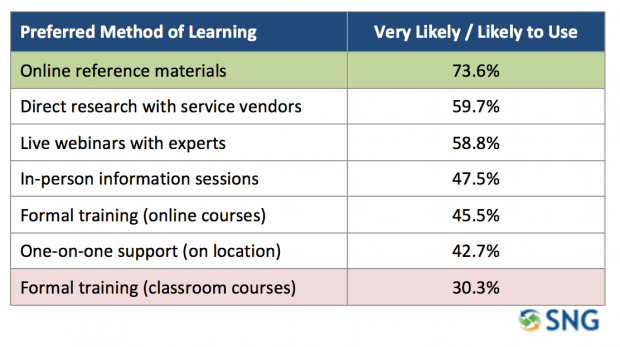
The classic classroom training session is the least appealing method of learning amongst businesses. This is consistent with the fact that “lack of time” is cited by SMEs as the biggest barrier to learning more about Internet applications. The more popular, learn-on-your-own-time method using online materials fits within the very nature of entrepreneurship, allowing business owners/managers to access materials when they need to, often during off business hours.
The challenge for communities and their economic development agencies is to both provide training in a myriad of ways and to also make the benefits of spending time with the training apparent and meaningful. Explain broadband’s benefits using the following learning methods to grow your local economy:
- Easy-to-use and understand online reference information and guides that focus on the business value of Internet applications.
- Webinars with experts and influencers on well-focused topics.
- A network of tech advisors who can assist businesses in sorting through their information needs and identifying needed sources of expertise.
Together, each of the learning methods above will help drive results. Compelling and accessible information delivered by influencers and case studies can motivate entrepreneurs. Tech evangelists and trainers can provide the hands-on guidance needed to help small businesses make the transition to more fully connected operations. Proactive post-training with motivated businesses will capitalize on their desire to grow their business, and with it your local economy.
When it comes to meaningful use of Internet applications that drive business growth, many small-medium enterprises (SMEs) are falling behind. They are challenged to do what they should and could be doing online to grow their business. There are a number of reasons for this including a lack of time, skills, knowledge and resources to effectively to determine what, why, and how they should do more online.
This is critical as effective business use of the Internet and its applications promotes local competitiveness and growth, especially with small-medium enterprises. Community leaders with an interest in truly harnessing the power of broadband and its applications to foster innovation and growth need to help businesses overcome these barriers to better leverage broadband’s potential.
SNG’s extensive research across North America reveals that higher business utilization of the Internet has a direct and positive impact on business financials – revenues, cost savings, and earnings. In short, driving broadband utilization has a positive impact on local economies, creating more (and better) jobs, opening opportunities for innovation, and aiding in business attraction and retention.
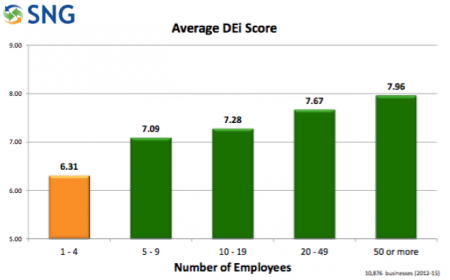 This does not mean that the majority of SMEs do not understand the correspondence to utilization and growth. In fact, the smaller the business is. SNG research shows these businesses unclear on benefits while having barriers to adoption that are by no means insurmountable. Reasons for NOT moving forward include:
This does not mean that the majority of SMEs do not understand the correspondence to utilization and growth. In fact, the smaller the business is. SNG research shows these businesses unclear on benefits while having barriers to adoption that are by no means insurmountable. Reasons for NOT moving forward include:
- Time and effort required to develop expertise
- Lack of internal resource with necessary skills
- Too much information – not enough time to research
- Lack of local external support resources
- Affordability of local external support resources
- Higher priorities to focus on
Lack of adequate speed further hinders full utilization, but bigger barriers exist. Many SMEs lack understanding on HOW to overcome barriers including privacy, security, and cost.
Economic development professionals have a compelling opportunity to confront this situation with activities to help businesses learn, fill the knowledge gap, and better understand just how much is to gain from a relatively low investment of time. Whether you deploy SNG’s solution, the Small Business Growth Program, or develop your own, make sure your efforts include the following steps:
-
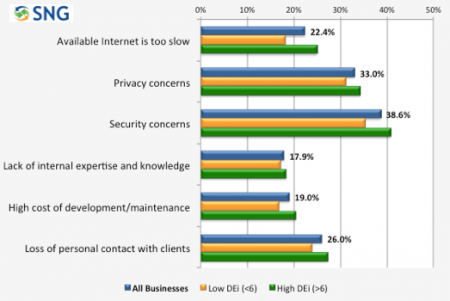 Create awareness of the opportunities and their potential importance to each business.
Create awareness of the opportunities and their potential importance to each business.
- Provide easy to access and easily digestible information to enlighten businesses on what is possible and reduce the fear of the unknown.
- Facilitate access to experts and others who can coach businesses through a process that provides a clear path to realizing these opportunities.
Communities across the nation are investing millions of dollars to upgrade their broadband but if they neglect to ensure that local businesses understand and have what it takes to use the transformative power of broadband, their returns on their investment will fall short. Deliberate targeted effort to driving full use of the power of broadband will fulfill the potential and maximize economic benefits.
 This is a major inhibitor to economic growth through broadband as SNG’s research shows that higher utilization of the Internet for online business activities brings higher revenues. SNG measures utilization using our own Digital Economy index (DEi), a normalized, weighted index of 17 potential online activities (eSolutions) covering a wide range of typical business functions. A DEi score of 10 means that all eSolutions are used, with a score of zero meaning that none are used. The average DEi score for SMEs is 6.6 (out of 10).
This is a major inhibitor to economic growth through broadband as SNG’s research shows that higher utilization of the Internet for online business activities brings higher revenues. SNG measures utilization using our own Digital Economy index (DEi), a normalized, weighted index of 17 potential online activities (eSolutions) covering a wide range of typical business functions. A DEi score of 10 means that all eSolutions are used, with a score of zero meaning that none are used. The average DEi score for SMEs is 6.6 (out of 10). Comparing DEi scores (utilization) with upload speeds we see a high correlation with high utilization when upload speeds are above 4 Mbps. Below 4 Mpbs the utilization drops off significantly.
Comparing DEi scores (utilization) with upload speeds we see a high correlation with high utilization when upload speeds are above 4 Mbps. Below 4 Mpbs the utilization drops off significantly.

 This does not mean that the majority of SMEs do not understand the correspondence to utilization and growth. In fact, the smaller the business is. SNG research shows these businesses unclear on benefits while having barriers to adoption that are by no means insurmountable. Reasons for NOT moving forward include:
This does not mean that the majority of SMEs do not understand the correspondence to utilization and growth. In fact, the smaller the business is. SNG research shows these businesses unclear on benefits while having barriers to adoption that are by no means insurmountable. Reasons for NOT moving forward include: Create awareness of the opportunities and their potential importance to each business.
Create awareness of the opportunities and their potential importance to each business.

